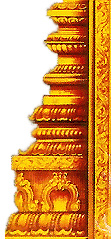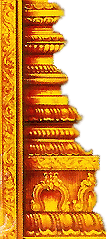| |
|
|
 | Singers: |  |
| |
|
|
| |
- |
|
| |
|
|
 |
Festival: |
 |
| |
|
|
| |
Aadi Pooram in July-August; Purattasi Navarathri in September-October; Karthikai in November-December; Vaikunda Ekadasi and Tiruvadhirai in December-January; and monthly pradoshams are celebrated in the temple. This is a twin temple for Both Lord Shiva and Lord Vishnu. |
|
| |
|
|
 |
Temple's Speciality: |
 |
| |
|
|
| |
This is a cave temple. While Dwarapalakas in temples traditionally appear with four hands, they have only two here. |
|
| |
|
|
 |
Opening Time: |  |
| | | |
| |
The temple is open from 7.00 a.m. to 11.00 a.m. and from 4.00 p.m. to 8.00 p.m. |
|
| | | |
 |
Address: |  |
| | | |
| |
Sri Ranganathar Temple, Malayadipatti, Pudukkottai district. |
|
| | | |
 |
Phone: |  |
| | | |
| |
+91 | |
|
| | |
 |
General Information: |  |
| |
|
|
| |
The temple has shrines for Lords Vinayaka, Muruga, Narasimha, Varahamurthi and Veerabadra, Saptha Madhas, Vakeeswarar, Mother Kalaikambal. Mother Kamalavalli Thayar graces from a separate shrine. |
|
| |
|
|
 |
Prayers |  |
|
|
| |
| |
Those suffering from impaired vision pray to Perumal – Lord Sri Ranganathar. | |
|
|
| |
 |
Thanks giving: |  |
|
|
| |
| |
Devotees light ghee lamps and offer Tulsi garlands to Perumal on Saturdays. | |
| |
| |
 |
Greatness Of Temple: |  |
| |
|
|
| |
The Artha Mandapam is next to the sanctum sanctorum of Lord Vakeeswara. The sculptures of Saptha Madhas, Ganesha, Veerabadra, Lords Shiva and Vishnu are carved in the hill temple. The sculptures of group of deities as Kalaikambal, Mahishasuramardini are outstanding examples of the skill of temple architecture. The Mandap near the cave is based on the Vijaya Nagara style. Following the Pallava style, the Dwarapalakas (Security before the sanctum sanctorum) have only two hands against four hands traditionally we see in temples.
Sanctum sanctorum of Lord Sri Ranganatha also has a front mandap. The pillars are standing on a lion looking majestically. This belongs to Pallava style. The figures of Lords Narasimha and Varahamurthi and Perumal with His consorts are carved beautifully in the walls of this mandap. Lord Sri Ranganatha in the sanctum sanctorum graces the devotees in his reclining posture with Lord Brahmma appearing from His naval. Divine serpent Adisesha with its hoods appear as an umbrella to Lord. In the wall behind, there are sculptures of both Devas and demons. The sculpture style of Lord Sri Ranganatha in His Anathasayana style – reclining style is very beautiful. The shrine of Thayar appears to be too ancient. There is also am epigraphic evidence that one Achuthappa Naicker contributed liberally for the temple in 16th century.
There are also some ancient cave temples nearby in Kaliapatti, Virasalur also under the administration of ASI. As both Lords Shiva and Vishnu grace in the Malayadipatti temple, people undertake Girivalam on Pradosha days. Festivals like Vaikunda Ekadasi and Shivrathri are celebrated grandly in the temple. Special pujas are dedicated to Lord Vishnu on Tiruvonam star days. As Perumal grants eye-boon to those suffering from impaired vision, He is praised as Kan (eye) Oli (vision) Vazhangum (giver) Perumal – Kan Oli Vazhangum Perumal. |
|
| |
|
|
 |
Temple History: |  |
| |
|
|
| |
Malayadipatti temple is one as the Tirumayam cave temple for both Lords Shiva and Vishnu. According to epigraphic details, the name of the place is Tiruvalathur. The two temples – Shiva and Vishnu temples – are side by side. The Vishnu temple with Lord Sri Ranganathar in His reclining posture is considered equal to Tirupathi.
The Shiva temple is more ancient than the Vishnu temple according to findings of the ASI. It belongs to the Pallava period. The temple was built in the 16th ruling year of one Kuvavan Sathan in 730 AD. He built the Shiva temple and named the presiding deity Vakeeswarar, according to epigraphic notes. |
|
| |
|
|
 |
Special Features: |  |
| |
|
|
| |
Miracle Based:
This is a cave temple. The Dwarapalakas of the temple have only two hands against the four hands generally seen in our temples.
|
|
| |
|
|
|
| |
|
|





